Recipe, page 186.
It seemed simple enough at the beginning. Two components — Mango Purée and Soy Pudding.
Then I realized I didn’t have an antigriddle or dry ice. Nor the cool eyepiece serviceware from Crucial Detail. Let’s try it the old fashioned way, suggested my daughter. In the freezer! Turned out okay after all. And I experienced agar agar for the first time. I’m going have to experiment with that some more.
Mango Purée
2 ripe mangoes
Simple syrup, to taste
So this is easy. I peeled and cut up the mangoes, then blended the hell out of em.
Oh. I guess I need to add one more thing to my list of missing equipment. The cookbook says “using refractometer, measure sugar content of mango purée. Stir in enough simple syrup to register 20º Brix.”
I’m not a chef, but…
Number one: what’s a refractometer, and why do I need one? Why not just add enough to taste? And number two: What’s “Brix,” a scale of measurement? After a bit of hurried research, I found out.
The Brix scale measures the mass ratio of dissolved sugar-to-water in a liquid. So 20º Brix (or, abbreviated 20º Bx) means that there is a 20% sugar-to-water ratio in the mango purée. Aaaahhh. I get it. It’s like Chef Grant Achatz says, “We like explosive tastes. We don’t dilute flavors, period.”
And a refractometer is used to “determine the refractive index of a substance.” In our case, measure the sugar content of a liquid. Brewers and vintners routinely use them while crafting their precious liquids. Speaking of liquids, the refractometer is also used for measuring blood, urine, antifreeze and aquarium salinity. But we’re not gonna go there.
And I’m not buying one either, so I added the simple syrup to taste.
And blended until very smooth. Then strained through my very expensive French chinois, then transferred to squeeze bottle. You could also use a superbag, a fine china cap, or garden-variety strainer just as well.
Soy Pudding
Kikkoman “Less Sodium” soy sauce
C&H cane sugar
Kaly’s agar agar, from L’Epicerie
I brought the soy, sugar and agar to a boil for about two minutes. Actually a little longer, because we were having fun taking pictures and watching the mixture foam up when whisked. The stuff’s really kinda cool.
Then I strained through a chinois into a glass bowl.
The soy-agar mixture immediately formed a gelatinous film on the glass when swirled around a bit, even before it had cooled much. I found that the recipe made much more needed for this dish, so I got to thinking. I refrigerated about half of the liquid for a couple of hours.
I covered a half sheet with a silpat mat and poured the reserved liquid out in a thin layer. It started to set up immediately. After an hour or so, I had a gelatinized layer of soy to play around with. I cut up long strands of the stuff and used them to top our stir fry dinner. Mmmm.
My daughter had fun with it too!
After the refrigerated portion had set, I transferred it to the blender, and blended until it was smooth and pudding-gy.
“Transfer to squeeze bottle,” the cookbook says.
Think about it. Or, rather, think about it this way, “transfer pudding to squeeze bottle.” Pudding.
It didn’t help that I was out of large squeeze bottles either. I resorted to using a small squeeze bottle from a bulk set I had purchased at the craft store, Michael’s.
“Transfer pudding to teeny, tiny mouthed squeeze bottle.” And bear the brunt of your progeny’s ridicule while doing so.
Even Willy the cat thought I was crazy, and he’s only 3 months old.
Assembly
Kadoya sesame oil
Piece dried bonito or bonito flakes
This is where you’re supposed to squeeze 2g portions of mango purée onto your antigriddle. You can also take a sheet pan and put it atop a block of dry ice if you happen to have one laying around. I opted for portioning it out into several divided ceramic serving dishes I had, which moulded the purée into square bricks, rather than the doughnut shapes presented in the book. Then I put them in the freezer for about an hour.
I took them out of the freezer and plated. Put each mango square into a small dish, and carved just the slightest dimple atop each. Added a drop of sesame oil to each dimple. Then topped with a dollop of my infamous soy pudding. The cookbook suggests using a Microplane to grate a light dusting of bonito onto each. I used bonito flakes I had from Zion Market, crumpled up into a smaller dusting with my fingers.
At Alinea they use the coolest stainless steel canapé picks, which I wish I could find somewhere. I ended up using a 99¢ package of stainless turkey lacing pins.
Well, by the time I took the picture it had started melting, but it tasted great! The perfect salty-sweet paradox, with touch of sesame.
Equipment:
Knife and cutting board
Osterizer blender
Squeeze bottles
Salter digital scale
Measuring bowls
Stainless mixing bowl
Medium saucepan
Wire whisk
Glass bowl
Spatulas
Optional:
Refractometer
Antigriddle
Silpat non-stick baking mat
Half sheet baking tray
Serveware:
2 Six-bay ceramic serving dishes, from Marukai
12 Single portion ceramic dishes, Marukai
2 sets Heuck “No-Sew” stainless turkey lacer pins
Yields: 8-12 servings

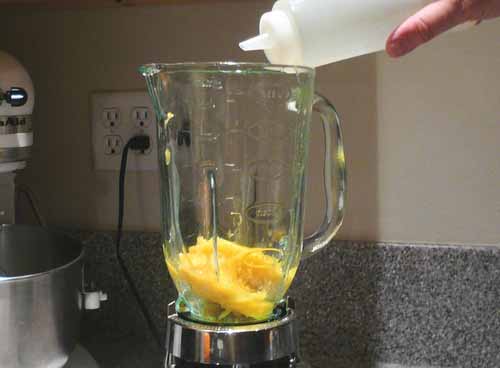
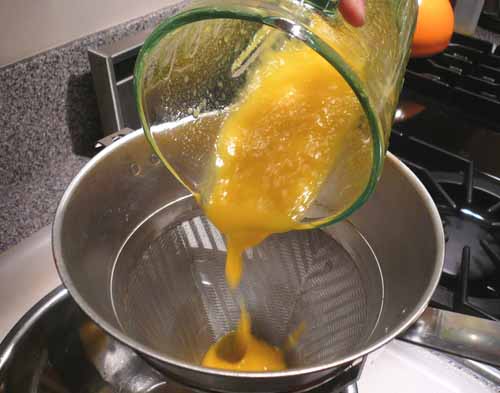
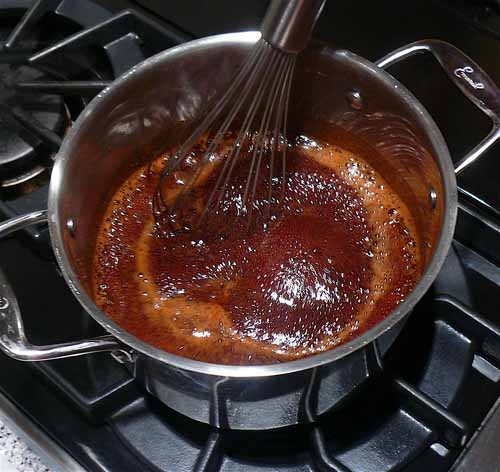
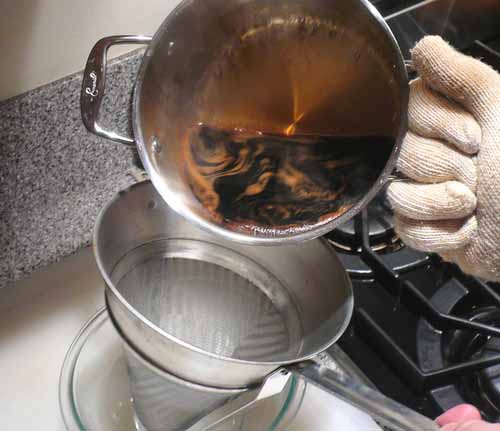

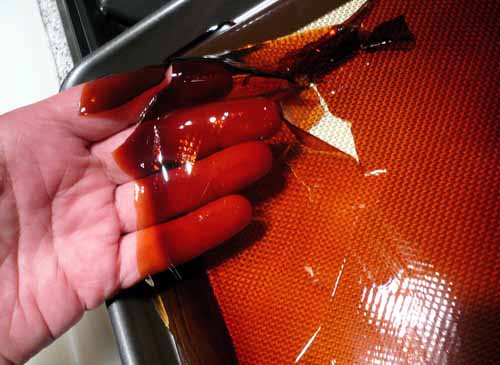
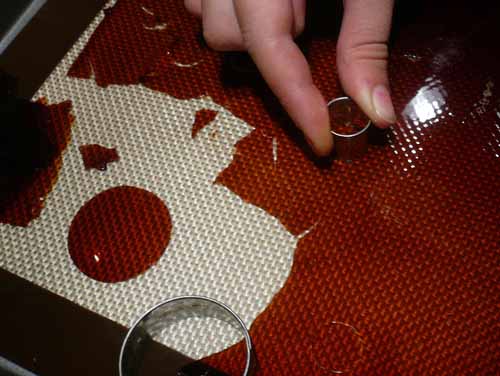
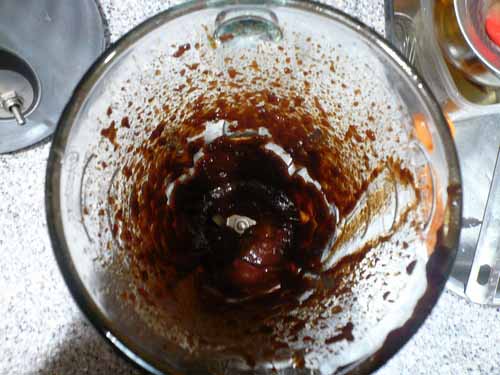
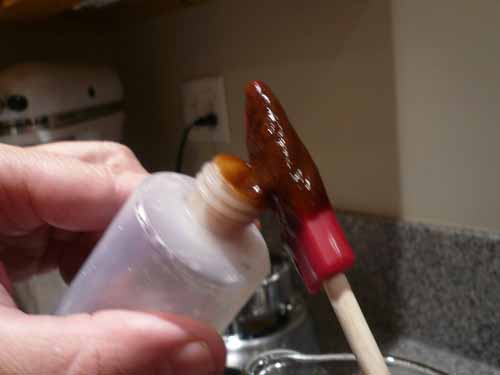
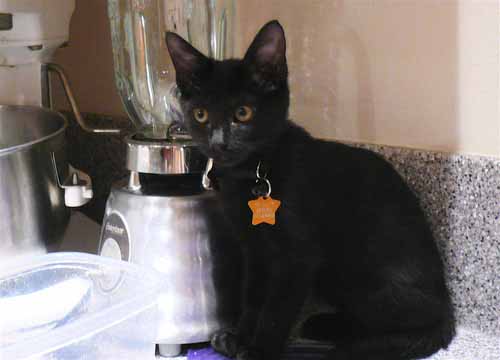
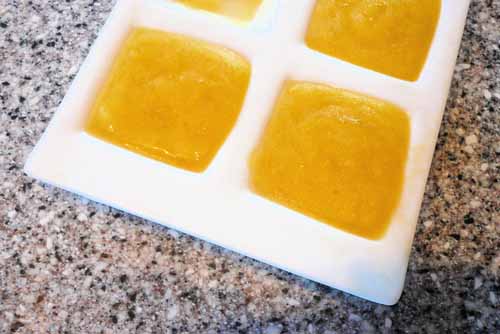
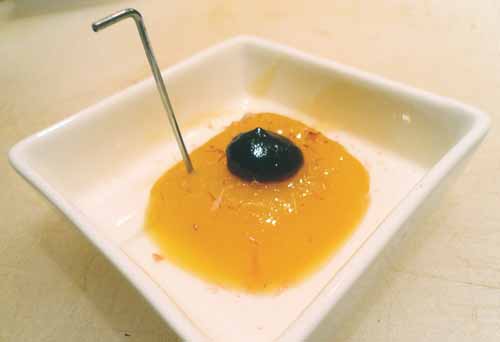
2 Responses to MANGO, Bonito, Soy, Sesame